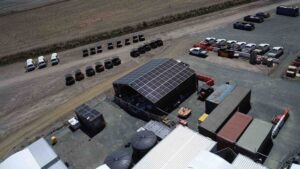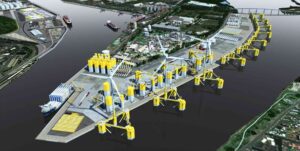A senior executive from aerospace industry giant Airbus has told an online audience that the company may launch a commercial airliner running on green hydrogen by the early 2030s.
Glenn Llewellyn, vice president of zero-emissions technology at Airbus, spoke at the “Clean Flight – Path to Zero Emissions Aircraft” panel at last week’s virtual Farnborough Airshow, and according to Llewellyn, green hydrogen – which is hydrogen created by renewable energy sources – as an aircraft fuel was “one of the most promising routes” for the aviation sector to meet its zero-emission goals.
Llewellyn described green hydrogen a having a “very attractive” outlook for fuelling aircraft with up to 200 passengers, and potential application through combustion in engines or in fuel-cell technologies that produce electric power. Llewellyn suggested that onboard hydrogen cells could be used to drive gas turbines or a hybrid-electric combination which would enable a significant reduction in aviation’s effect on climate change.
Further, both “raw” hydrogen as well as carbon-neutral sustainable aviation fuels (SAF) both have important parts to play in the aviation sector’s flight towards zero emissions. Indeed, carbon-neutral SAFs – produced using renewable feedstock as an alternative to conventional jet fuels – are likely to remain the more attractive option for larger aircraft making longer journeys until at least the middle of the century.
However, Llewellyn was quick to warn that there must be “significant” decisions made over the coming years to ensure that green hydrogen technology can be developed. Unsurprisingly, then, Llewellyn explained that “We are talking about making some significant decisions in the 2024 to 2025 timeframes in terms of the technology choices we need to make.”
“We’ve been very clear recently that we have the ambition to bring a zero-emissions commercial airliner to market in the early 2030s, and one of the most promising technologies to allow us to do that is hydrogen,” Llewellyn said.
“We believe we need to position the aviation industry to be powered by renewable energy, and hydrogen is a very good surrogate for allowing us to do that.”
“It can be produced directly by solar and wind, and we can then carry that energy onboard, either in fuel cells or combustion in a gas turbine, or even a hybrid-electric combination of the two.”
Llewellyn spoke of the need to reach beyond “aircraft borders” into the automotive and space sectors to borrow on their experience with hydrogen energy use. Additionally, Airbus believes the airport community must also begin preparing for hydrogen-powered aircraft in the 2030s, meaning bringing hydrogen into airports to power ground vehicles.
“That’s going to require work already starting today,” not just for aircraft but preparing the roadmap. “That infrastructure piece is as important as the aircraft development piece,” noted Llewellyn. Airbus already has begun initial work on such infrastructure preparation, as well as reaching out to energy companies to scale for hydrogen usage.
Riona Armesmith, chief project engineer for hybrid-electric propulsion for Rolls-Royce, agreed that in the short term “we’ve absolutely demonstrated” that the industry can use SAFs immediately. “Hydrogen needs a bit more work” for use in gas turbines, but it is something Rolls-Royce is examining, along with electric. “It would be an easy to thing to say it is an either-or. It’s not; It’s both,” Armesmith added, explaining that the industry needs to support such efforts to push them forward “rather than just waiting to see what happens.”
“Nobody’s under the illusion that there’s one technology that’s going to solve [sustainability challenges],” agreed Eamonn Beirne, head of emerging aviation technologies for the UK Department for Transport. SAF stands as the most immediate approach, but other means, including hydrogen, look as if they can help deliver on sustainability.
“There are huge opportunities,” said Russ Dunn, chief technology officer and head of strategy for GKN Aerospace, who noted that most aircraft developed today are employing older technologies, despite significant advances over recent years. SAFs are possible but needs the right economic conditions, Dunn added. However, “there are huge advances that you can make beyond that,” he said. “SAF is an important ingredient…but one of the ingredients.”
Further opportunities also exist in areas such as hydrogen and electric. “Not one of those individual ingredients will meet the requirements for zero-emissions aviation for net-zero 2050,” said Dunn, who added that the community must address new technologies, support SAFs, and explore emerging technologies such as the use of hydrogen. “Yes, there are huge challenges to overcome but they are all are within our grasp.”










